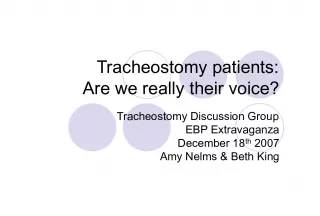"EBP & Tracheostomy: JUST DOing IT"


This session, presented by Emma Clifton, a senior speech pathologist at Blacktown and Mt Druitt Hospitals, is part of the NSW Speech Pathology
- Uploaded on | 1 Views
-
 hazelhall
hazelhall
About "EBP & Tracheostomy: JUST DOing IT"
PowerPoint presentation about '"EBP & Tracheostomy: JUST DOing IT"'. This presentation describes the topic on This session, presented by Emma Clifton, a senior speech pathologist at Blacktown and Mt Druitt Hospitals, is part of the NSW Speech Pathology. The key topics included in this slideshow are . Download this presentation absolutely free.
Presentation Transcript
Slide1EBP & Tracheostomy:JUST DO ing IT NSW Speech Pathology EBP Network EBP Extravaganza 6 December 2006 Emma Clifton Senior Speech Pathologist Blacktown & Mt Druitt Hospitals (02) 9881 8612 Emma.Clifton@swahs.health.nsw.gov.au
Slide2 Session Outline Tracheostomy CATs & CAPs … what’s new? Tracheostomy EBP & clinical practice … an emerging relationship Tracheostomy EBP & the workplace … JUST DO ing IT
Slide3Tracheostomy CATs & CAPs …What’s new? Clinical Question In non-ventilated patients with tracheostomy tubes, does occlusion with a Passy Muir Speaking Valve (PMSV) or a one-way valve reduce aspiration? CAPs Dettelbach et al 1995 Elpern et al 2000 Gross et al 2003 Stachler et al 1996 Suiter et al 2003 Clinical Bottom Line Occlusion will not always eliminate aspiration, but it can reduce aspiration with thin fluids Modified Barium Swallow (MBS) recommended due to high silent aspiration risk Changing TDG Clinical Practice It is not assumed that if aspiration is occurring that it will be eliminated by use of a PMSV/one-way speaking valve, but highlights that more objective assessment is frequently indicated
Slide4Tracheostomy CATs & CAPs …What’s new? Clinical Question In non-ventilated patients with head/neck cancer and tracheostomy tubes, does occlusion reduce aspiration? CAPs Leder et al 1998 Logemann et al 1998 Muz et al 1989 Stachler et al 1996 Clinical Bottom Line Occlusion can reduce aspiration with some of these patients, possibly due to changes in swallowing bio-mechanics Occlusion immediately post-surgery ineffective in reducing aspiration MBS recommended
Slide5Tracheostomy CATs & CAPs …What’s new? Clinical Question In non-ventilated patients with tracheostomy tubes, does digital occlusion reduce aspiration? CAPs Leder et al 1996 Leder et al 2001 Logemann et al 1998 Clinical Bottom Line Occlusion does not appear to not make a significant difference in eliminating aspiration MBS recommended
Slide6Tracheostomy CATs & CAPs …What’s new? Clinical Question In patients with tracheostomy tubes, is the Modified Evans Blue Dye Test (MEBDT) an effective clinical indicator in determining aspiration? CAPs O’Neill-Pirozzi et al 2003 Belafsky et al 1999 Belafsky et al 2003 Brady et al 1999 Donzelli et al 2001 Thompson-Henry & Braddock 1995 Peruzzi et al 2001 Clinical Bottom Line MEBDT may not be sensitive enough to detect trace aspiration, both high false -ve rates - when suctioned, up to ~ 46% of the time no blue dyed material will be returned when aspiration has occurred under FEES and MBS high false +ve rates - when suctioned, up to ~ 20% of the time return of blue dyed material does not actually represent aspiration of item tested eg. was it puree? OR was it saliva? Note also that food/fluid/saliva can be suctioned from the supraglottis rather than aspirated material Changing TDG Clinical Practice Clinical Pathways for RPA and Liverpool Hospital no longer state that the MEBDT is essential in the Speech Pathologist’s toolbag
Slide7Tracheostomy CATs & CAPs …What’s new? Clinical Question In non-ventilated patients with tracheostomy tubes, is capping indicated for safe and effective decannulation? CAP Thompson-Ward et al 1999 Clinical Bottom Line Down-sizing + capping and 24-48 hrs cuff deflation both effective < 3% re-cannulation with both protocols 24-48 hrs cuff deflation more efficient in facilitating earlier decannulation and reducing medical costs Changing TDG Clinical Practice Capping not being a ‘must-do’ before safe and effective decannulation
Slide8Tracheostomy CATs & CAPs …What’s new? Clinical Question Is it safe to feed patients with the tracheostomy cuff inflated? CAPs Pinkus 1973 Clinical Bottom Line Patients with tracheostomy tubes should be fed non-orally due to aspiration risk … TDG currently re-visiting ...
Slide9Tracheostomy EBP & clinical practice …An emerging relationship Other considerations: The time factor … to have discussions to ‘let go’ of tools and beliefs to apply the evidence Some clinical questions where you would expect many papers, to be out there are not Robustness of studies in existence
Slide10Tracheostomy EBP & the workplace …JUST DO ing IT Having CAPs and CATs with us when seeing patients Utilising the tracheostomy listserve Liaising with Librarians for automatic notification of new articles for our CIAP search Time managing for EBP Being aware of what exactly is out there, so as to be able to assert view from a position of strength
Slide11References NSW Speech Pathology EBP Network: Tracheostomy Education for NSW Speech Pathologists
